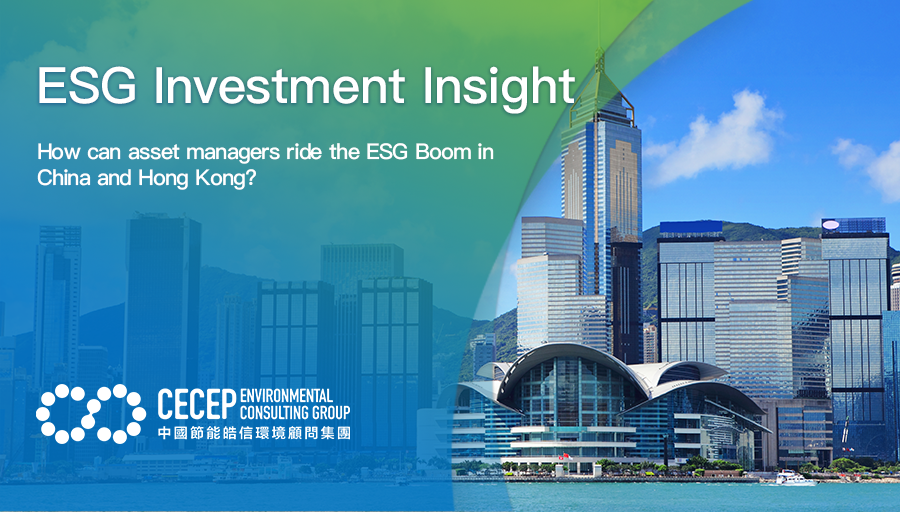【ESG Investment Insight】How can asset managers ride the ESG Boom in China and Hong Kong?

Foreword
For different stakeholders of the investment industry, “ESG investing”, “sustainable investing”, “socially responsible investing” and “impact investing” can have different meanings. But all these terms are continuing to warrant the attention of investors and regulators, as the past few years have seen the remarkable growth of ESG and sustainable assets across the global markets and asset classes. According to the Global Sustainable Investment Alliance (“GSIA”)[i] more than one-third of global total assets under management (“AUM”) are sustainable investments.
Landscape of Sustainable Funds
According to the latest statistics from Morningstar[ii], out of the total global sustainable fund assets of US$ 2.47 trillion, Europe continued to lead the sustainable fund market by a significant margin, making up 82% of global sustainable fund assets, followed by the United States (12%). China (about 1.9%) is the third largest sustainable fund market, which made up more than 75% of the Asia ex-Japan region's asset base. Next in line are Australia/New Zealand, Japan and Canada, each making up about 1% of the global sustainable fund assets.
Although net fund flows into global sustainable funds dropped in 2022 Q2, and global sustainable fund assets recorded another quarterly decline to US$ 2.47 trillion as of June 2022, sustainable fund flows and assets have withstood the impact from fears of rising interest rates, inflation and recession better than the overall fund market. There were also a healthy amount of global sustainable fund launches in 2022 Q2. Therefore, the momentum of ESG investing is still strong and the market outlook remains optimistic.
Asset Managers Face Mounting Scrutiny
To address the risk of greenwashing inherent in the proliferation of ESG funds, asset owners, regulators, industry associations and other stakeholders across the markets have been pushing for more rules and regulations for asset managers.
European Union
In the European Union (“EU”), the regulatory framework for sustainable finance is far more established than other markets. The below overview of the regulations applicable to asset managers in the EU gives us an idea of the magnitude of scrutiny asset managers may face in the ESG era.
Built upon the EU Taxonomy for sustainable activities, investors are further subject to the Sustainable Finance Disclosure Regulation (“SFDR”), just as large corporations and listed companies are subject to the Corporate Sustainability Reporting Directive (“CSRD”). Under the SFDR, key indicators from both the environmental and social aspects are required to disclose the Principal Adverse Impacts.
Investment strategies are classified and labelled under either Article 6, 8 or 9 of the SFDR[iii]. In short, “Article 8” financial products are those that promote environmental and social characteristics, given the investee companies follow good governance practices. “Article 9” financial products are those that have sustainable investment as the objective and an index has been designated as a reference benchmark. Financial products that do not fit these two categories are “Article 6” financial products. Article 6 of the SFDR requires reporting on sustainability risks, and Articles 8 and 9 require additional disclosure requirements. In practice, however, it may be difficult to be a 100% sustainable fund for practical reasons. Morningstar estimated that there are about 950 Article 9 funds in total, out of which about 40% of them have a sustainable investment target of less than 50%, 2.5% of them have a target of higher than 90%, and a mere dozen of them have a goal of 100% sustainable investments. Under the current expectations of regulators in the EU for Article 9 funds to almost exclusively invest in sustainable investments, asset managers are pressed to raise their minimum investment threshold in sustainable investments in order to keep the Article 9 designation. Otherwise, the remaining option is to reclassify their Article 9 funds as Article 8 funds, just as several large asset managers, including PIMCO and Goldman Sachs’s NN Investment Partners, have done in recent months.[iv]
In addition, the European Securities and Markets Authority (“ESMA”) released a supervisory briefing in May 2022[v] to provide guidance for the supervision of fund documentation and marketing material, principles-based guidance on the use of sustainability-related terms in funds’ names and integration of sustainability risks by asset managers.
United States
In March 2022, the US Securities and Exchange Commission (“SEC”) proposed climate-related disclosure requirements for domestic and foreign registrants based on the Task Force on Climate-related Financial Disclosures (“TCFD”) reporting framework. In May 2022, the SEC proposed additional rules that are applicable to ESG funds[vi]. For funds that include sustainability-related terms in their names, they would be required to invest at least 80% of fund assets in the investments suggested by the fund names. This is an expansion of the existing 80% investment policy requirement for investment funds, which prohibits materially deceptive or misleading names. The SEC also proposed varying disclosure requirements on the ESG criteria considered in the investment process, for ESG funds that are categorized as “Integration Funds”, “ESG-focused Funds” and “Impact Funds” (i.e. a subset of “ESG-focused Funds”).
China and Hong Kong
In Mainland China, ESG funds have received vocal support from regulators. In a statement released in April 2022[vii], the Chinese Securities Regulatory Commission (“CSRC”) urges the development of ESG public funds, green finance and responsible investment. As the ESG fund market in China only makes up less than 2% of the global market now, there is still a lot of room for growth. Although there are currently no regulations regarding the naming or disclosure of ESG funds, it is logical to be well prepared ahead of any eventual regulations in the future.
In Hong Kong, the Securities and Futures Commission (“SFC”) issued a revised circular in June 2021[viii] to enhance the requirements applicable to SFC-authorized funds which consider ESG factors in their investment process. “ESG funds” have to incorporate ESG factors as their key investment focus and reflect such in the investment objective and/or strategy. ESG or similar terms used in the funds’ names should accurately and proportionately reflect the ESG features. ESG funds should disclose in the offering documents the ESG focus of the fund, the ESG investment strategy, asset allocation, reference benchmark, additional information reference and risks, with additional information of the ESG fund or the fund manager or the index provider, as appropriate. The SFC has also been publishing a list of SFC-authorized ESG funds on an official webpage[ix].
In August 2021[x], the SFC amended the Fund Manager Code of Conduct (“FMCC”) to introduce disclosure requirements for climate-related risks, with reference to the TCFD Recommendations. Under the revised FMCC, baseline requirements are introduced to cover disclosures on governance, investment management and risk management. Enhanced standards are applicable to Large Fund Managers (i.e. whose AUM equal or exceed HK$8 billion), who are expected to adopt scenario analysis in evaluating the resilience of investment strategies to climate-related risks under different pathways, and identify portfolio carbon footprints of Scope 1 and Scope 2 (Scope 3 is encouraged) greenhouse gas emissions associated with the funds’ underlying investments. Large Fund Managers need comply with the baseline requirements starting from 20 August 2022, and the enhanced standards from 20 November 2022. Other Fund Managers need to comply with the baseline requirements also from 20 November 2022.
Earlier in 2022, the CSRC and the SFC jointly approved the inclusion by Mainland and Hong Kong exchanges of eligible ETFs in mutual stock market access between the Mainland and Hong Kong (“Stock Connect”), with the aim of promoting the development of capital markets in both mainland China and Hong Kong. The trading of ETFs under Stock Connect commenced on 4 July 2022. This presents vast opportunities for managers of ESG funds.
How CECEP can help asset managers in China and Hong Kong
For asset managers in China and Hong Kong, whether you are already managing labelled ESG funds, or are still contemplating ESG fund launches, CECEPEC is well positioned to help you succeed as your trusted advisor. With a proven track record in sustainability and climate reporting, we can help you prepare for the forthcoming disclosure regime for climate-related risks that will continue developing. With our breadth and depth of experience from advising governments, regulators, financial institutions and listed corporations, we have the insight to provide sustainability-related risk and opportunity analysis, ESG Due Diligence, investor engagement service and other high-value-added services throughout your investment cycle.
Conclusion
As a convening member of the Hong Kong Green Finance Association, CECEPEC is committed to supporting Hong Kong’s continual success as a leading ESG asset management hub and contribution to supporting the development of ESG investing in the Greater Bay Area and Mainland China. Reach out to us and let us share how we can support you in navigating the continuously evolving world of asset management and succeeding together.
Reference:
[i] Global Sustainable Investment Alliance (July 2021). Global Sustainable Investment Review 2020. Retrieved from http://www.gsi-alliance.org/wp-content/uploads/2021/08/GSIR-20201.pdf
[ii] Morningstar (July 2022). Global Sustainable Fund Flows Report – Q2 2022. Retrieved from https://www.morningstar.com/lp/global-esg-flows[iii] Regulation (EU) 2019/2088 of the European Parliament and of the Council of 27 November 2019 on sustainability‐related disclosures in the financial services sector. Retrieved from https://eur-lex.europa.eu/legal-content/EN/TXT/PDF/?uri=CELEX:32019R2088&rid=1
[iv] Bloomberg (14 September 2022). Asset Managers Are Facing Hundreds of ESG Fund Downgrades.
[v] Supervisory briefing - Sustainability risks and disclosures in the area of investment management. Retrieved from https://www.esma.europa.eu/sites/default/files/library/esma34-45-1427_supervisory_briefing_on_sustainability_risks_and_disclosures.pdf
[vi] Laura Ferrell, Sarah Fortt, and Betty Huber, Latham & Watkins LLP (20 June 2022). Proposed ESG Disclosure Requirements for Investment Advisers and Investment Companies. Retrieved from https://corpgov.law.harvard.edu/2022/06/20/proposed-esg-disclosure-requirements-for-investment-advisers-and-investment-companies/
[vii] China Securities Regulatory Commission (26 April 2022). 关于加快推进公募基金行业高质量发展的意见. Retrieved from http://www.csrc.gov.cn/csrc/c100028/c2368241/content.shtml
[viii] Circular to management companies of SFC-authorized unit trusts and mutual funds - ESG funds. Retrieved from https://apps.sfc.hk/edistributionWeb/gateway/EN/circular/products/product-authorization/doc?refNo=21EC27
[ix] List of ESG funds. Retrieved from https://www.sfc.hk/en/Regulatory-functions/Products/List-of-ESG-funds
[x] Circular to licensed corporations – Management and disclosure of climate-related risks by fund managers. Retrieved from https://apps.sfc.hk/edistributionWeb/gateway/EN/circular/intermediaries/supervision/doc?refNo=21EC31
- Subscribe Us On WeChat -
Official accounts:中節能皓信CECEPEC

中國節能皓信環境顧問集團
CECEP ENVIRONMENTAL CONSULTING GROUP
Sustainability | Environment & Climate | Sustainable Finance
Green Building | EnvAI 2.0 | Professional Training
